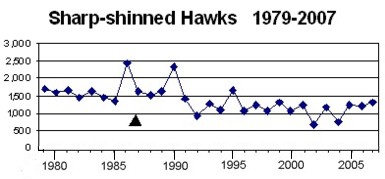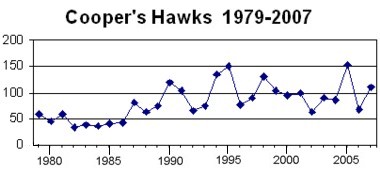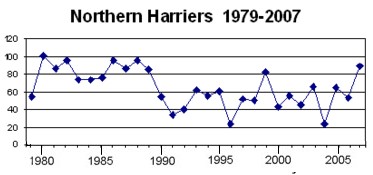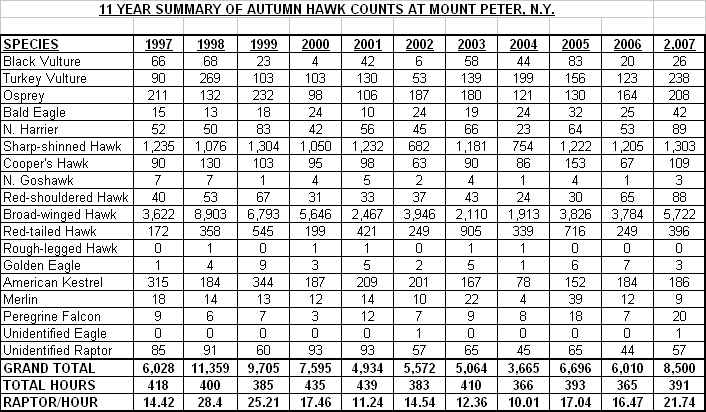Compiler: Judy Cinquina Location
2007 Report
#11_Year_Summary #10_Year_AverageMount Peter celebrated its 50th consecutive fall hawk watch in 2007. Manned by very dedicated volunteers between September 1 and November 15, the 67-day watch recorded an above average 8,500 raptors. Translating to 21.7 hawks per hour, our 2007 count included record Bald Eagles, near record Peregrine Falcons, and increases in Northern Harriers, Red-shouldered Hawks, and American Kestrels.
After six consecutive years of low tallies, Broad-winged Hawks finally rewarded us with four straight 500+ days, September 16 19. At seasons end, 5,701 Broad-wings were counted. Our largest tally, 10,944 in 1971. Red-shouldered Hawks also showed well, with 88 recorded, our fourth best season. The majority moved through on just three days: October 25 and 28 and November 2. Most were adults (48) with the rest immature (12) or unknown (28). Notoriously unpredictable at our lookout, their 10-year average is a moderate 42, and yet, 109 turned up in 1995. As is sometimes the case, a strong Red-tailed Hawk movement failed once again to materialize before our watch ended. The 396 count was 56% lower than our 905 record established in 2003. For the third consecutive fall, an albino Tail was spotted over the lookout. No Rough-legged Hawks were noted this season, but thats not unusual. Our 10-year average hovers around 1, and our record was 5 in 1990.
Slightly above average Sharp-shinned and Coopers Hawks moved through this season. Sharpies posted double-digit numbers almost daily, but never approached the daily record of 337, set on September 29, 1986. The final tally of 1,303 reflects a slight decline since our watch was extended into November in 1979.
Between 79 and 86, Sharpies averaged 1,652 a season, while Coopers Hawks averaged 44. But 1987 marked a turning point for both species; with Sharpies declining 34% to their current average of 1,094 while Coopers Hawks increased 123% to a 98 average. Counters logged a healthy 109 Coopers Hawks this year. The three Northern Goshawks seen this fall was slightly below our recent average. Between 79 and 91, we did score higher counts of this rare accipiter, including a record of 12 in 82, 83, and 91.
There is no doubt that American Kestrels are declining, as their habitat disappears under housing tracts. This year, we recorded 186: including 11 males, 43 females, and 102 unknown. Its difficult to wrap your mind around the fact that in 1965, 210 Kestrels were counted on September 11, while this century has yet to produce that number for an entire season! Historically, most falcons migrate along the coast and comparatively few are recorded at inland watch sites. Nevertheless, Mount Peter has witnessed an increase in both Merlins and Peregrine Falcons since the 1980s, with Merlins setting a record of 39 in 2005 and Peregrines bringing in a near record this fall of 20 (1990 produced a record 21).
The Osprey count was above average in 2007, with most coming through at the end of September, peaking at 24 on September 25. Our final count of 208 was not far behind the record 233 in 1990. Our Northern Harrier count of 89 was our best count in almost two decades. In 1990, Harriers began a decade-long decline of 39%. This seasons Harrier breakdown was: 46 immature, 12 female, 5 male, and 26 unknown. Record Bald Eagles helped us celebrate our 50th anniversary: 22 adult and 20 immature. Our former record was 32, just two years ago. It took 31 years before we recorded double-digit eagles over Mount Peter. Our first 25 years averaged one Bald Eagle per season, while our current 10-year average is 20! Now, that is something to celebrate. We only noted three Golden Eagles this season: 1 adult, 2 immature. Even after extending our watch into November in 1980, our Golden Eagle average remained low. Then, suddenly in 1993, nine were counted. The next year, an all-time record of 12 appeared. Since then, their numbers have yo-yoed between 1 and 9, averaging out to 4 during the last ten years.
Only 4 Ruby-throated Hummingbirds were noted this fall. On September 20, one attacked a migrant Sharpie. Ken Witkowski counted 1,000+ Canada Geese on October 15, and Ajit Antony noted 2,016 the next day. Rick Hansen spotted the only Snow Geese, 500 on November 11, but no Brant were reported. Linda Peskac scored the high Monarch count with 260 on September 13. Local Common Ravens were with us almost daily, with up to three observed September 5. Other interesting sightings included:
September 1 first few Red-breasted Nuthatches (others, through 10/7), Purple Finch (daily)
September 4 Olive-sided Flycatcher
September 5 Canada, Black-throated Green, & Magnolia Warblers; first Ruby- crowned Kinglet
September 7 Red-eyed Vireo, first House Wren
September 9 Scarlet Tanager
September 13 Winter Wren, Chipping Sparrow, Rose-breasted Grosbeak
September 16 Am. Redstart, Blue-headed Vireo, 10 Bluebirds
September 18 4 Double-crested Cormorants
September 20 Pine Siskin, E. Towhee
September 24 Palm Warbler
October 4 first Junco and Yellow-rumped Warbler
October 10 first Golden-crowned Kinglet
October 17 Am. Tree Sparrow, Blackpoll Warbler
October 31 2 Common Loons (5 more on 11/9)
November 3 Evening Grosbeak
November 8 Woodcock flushed near platform (2 more 11/9)
November 9 20 Snow BuntingsMount Peter celebrated its 50th hawk watch with the best count recorded this century. We are grateful to visitors Diane Brown and Eileen Kopec for recording data on 9/8 and 10/21, respectively. A very big thank- you to all our very dedicated leaders who made our 50th happen, especially Ken Witkowski who stood watch for 18 days! We extend a warm welcome to new leaders Liza Antony, David Baker, Bill OKeefe, and Richard (Dick) Ryley. We are indebted to Tom Millard for putting up and taking down our box on the platform and to Ajit Antony for keeping the hawk watch going in October and maintaining our hourly data at http://www.hawkcount.org/. We are deeply grateful to the N.Y Department of Environmental Conservation for sending up a crew last January to clear trees and shrubs around our lookout. We also appreciate our sponsors, The Fyke Nature Association of Bergen County, NJ, who founded the watch in 1958. We are the oldest, continually run, all-volunteer fall watch in the county.




